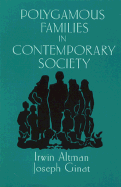Book contents
- Frontmatter
- Contents
- Foreword
- Preface and acknowledgments
- 1 Introduction
- Historical background
- Early stages of relationships
- Home environments of plural families
- Managing everyday life
- Social-emotional and family relationships
- Appendix A Methodology and procedure
- Appendix B Demographics of Mormon polygyny
- Notes
- References
- Index
1 - Introduction
Published online by Cambridge University Press: 05 May 2010
- Frontmatter
- Contents
- Foreword
- Preface and acknowledgments
- 1 Introduction
- Historical background
- Early stages of relationships
- Home environments of plural families
- Managing everyday life
- Social-emotional and family relationships
- Appendix A Methodology and procedure
- Appendix B Demographics of Mormon polygyny
- Notes
- References
- Index
Summary
Harry, now in his 60s, had been away from home on a business trip for several days. After a long drive he arrived at the family compound and was greeted by an excited group of about 20 of his 65 children and two of his five wives. Soon thereafter the other wives and more of his children came to see him. He and his children and wives greeted one another warmly, especially since it was the weekend of the monthly family reunion and meetings. Everyone was expected home that weekend, including Harry's 37 sons and 28 daughters and their families and more than 300 grandchildren and great-grandchildren.
William and his three wives – Carlyn, Danielle, and Alayna – have begun to achieve their dream of a home of their own in which they and their 12 children can live as a united family, in accordance with their religious beliefs. All converts to Mormon fundamentalism, they have struggled for years, living in rented apartments, basements of homes, and, during one hard winter, in a tent. In spite of ever-present economic strains, they finally began building their own home in a semirural area near Metropolitan City. The family has been in difficult financial straits, so construction goes slowly, they try to grow some of their own food, and they find whatever work they can in a tight economy.
- Type
- Chapter
- Information
- Polygamous Families in Contemporary Society , pp. 1 - 18Publisher: Cambridge University PressPrint publication year: 1996

